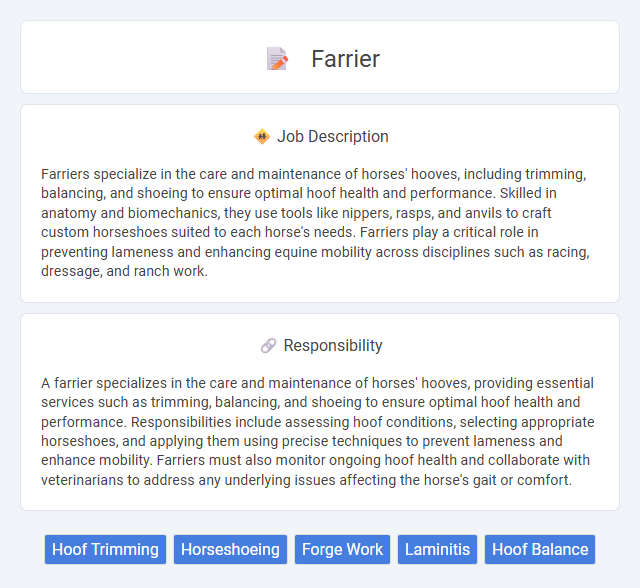
Farriers specialize in the care and maintenance of horses' hooves, including trimming, balancing, and shoeing to ensure optimal hoof health and performance. Skilled in anatomy and biomechanics, they use tools like nippers, rasps, and anvils to craft custom horseshoes suited to each horse's needs. Farriers play a critical role in preventing lameness and enhancing equine mobility across disciplines such as racing, dressage, and ranch work.
People with strong physical stamina and good hand-eye coordination are likely to be suitable for a farrier job, as it demands prolonged periods of standing, lifting, and working with horses' hooves. Individuals who have a high tolerance for working outdoors in various weather conditions might find this profession more compatible with their lifestyle. Those with a calm demeanor and the ability to handle large animals safely could have a higher probability of success and job satisfaction in this field.
Qualification
Farriers typically require specialized training in equine hoof care, including shoeing and trimming, often obtained through accredited farrier schools or apprenticeships. Certification from organizations such as the American Farrier's Association (AFA) or British Farriers and Blacksmiths Association (BFBA) enhances professional credibility and demonstrates proficiency in biomechanics and hoof anatomy. Practical experience with horses of various breeds and conditions is essential to develop the skills necessary for effective hoof health management and injury prevention.
Responsibility
A farrier specializes in the care and maintenance of horses' hooves, providing essential services such as trimming, balancing, and shoeing to ensure optimal hoof health and performance. Responsibilities include assessing hoof conditions, selecting appropriate horseshoes, and applying them using precise techniques to prevent lameness and enhance mobility. Farriers must also monitor ongoing hoof health and collaborate with veterinarians to address any underlying issues affecting the horse's gait or comfort.
Benefit
Working as a farrier may offer substantial benefits including steady demand due to the ongoing need for hoof care in horses, which might provide job stability. The role often allows for flexible hours and the opportunity to work outdoors, potentially improving job satisfaction and work-life balance. Skilled farriers could also experience competitive earnings and the chance to develop a specialized expertise in equine health.
Challenge
Farriers likely face the ongoing challenge of balancing precision and speed when shoeing horses, as each animal's hoof structure can vary significantly. The physical demands and potential risks of injury might increase the difficulty of consistently delivering high-quality work. Adapting to advancements in hoof care technology and varying client needs probably adds complexity to their daily tasks.
Career Advancement
Farrier career advancement involves progressing from entry-level shoeing and hoof care to specialized roles such as corrective farriery and veterinary collaboration. Gaining certifications from recognized bodies like the American Farrier's Association enhances professional credibility and opens opportunities for training apprentices or managing farrier clinics. Continuous education in anatomy, metallurgy, and hoof pathology is essential for higher-level consulting and involvement in competitive equine sports industries.
Key Terms
Hoof Trimming
Hoof trimming is a critical aspect of a farrier's job, ensuring the proper balance and health of horse hooves. Regular trimming prevents overgrowth, corrects irregular wear patterns, and helps avoid lameness or hoof-related injuries. Skilled farriers use specialized tools to carefully shape the hoof, promoting optimal weight distribution and overall equine performance.
Horseshoeing
Horseshoeing is a specialized farrier skill involving the crafting and fitting of metal shoes to horse hooves, ensuring proper hoof protection and alignment. Precision in trimming and shaping hooves is crucial to prevent injuries and improve equine performance. Farriers utilize tools like clinchers, rasps, and hammers while assessing hoof health for customized shoe applications.
Forge Work
Farriers specializing in forge work excel at shaping and customizing horseshoes through precise heating and hammering techniques in a forge. Mastery in metalworking tools and temperature control ensures optimal shoe fit and durability, directly enhancing equine hoof health and performance. Advanced forge skills enable farriers to create specialized shoe designs that address specific biomechanical needs in various horse disciplines.
Laminitis
Farriers play a critical role in managing laminitis, a painful inflammatory condition affecting the horse's hooves. Proper trimming and shoeing techniques help alleviate pressure on the laminae, promoting hoof stability and reducing the risk of further damage. Collaboration between farriers and veterinarians is essential for designing customized therapeutic shoeing that supports laminitis recovery and prevents recurrence.
Hoof Balance
Farriers specialize in hoof balance to ensure proper weight distribution and prevent lameness in horses. Precise trimming and shoeing techniques optimize hoof alignment, contributing to overall equine health and performance. Regular assessments of hoof angles and sole depth maintain structural integrity and enhance mobility.
 kuljobs.com
kuljobs.com